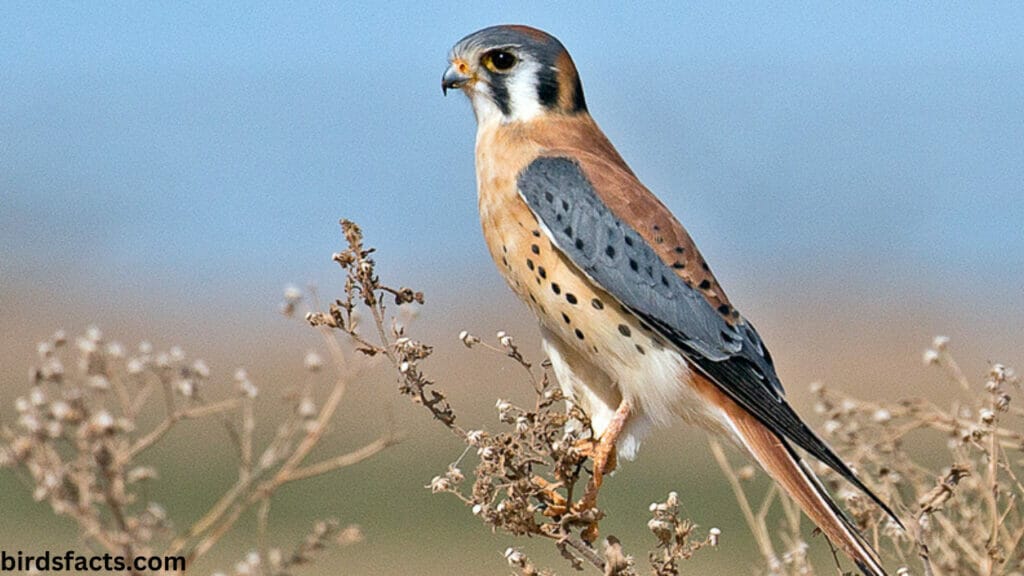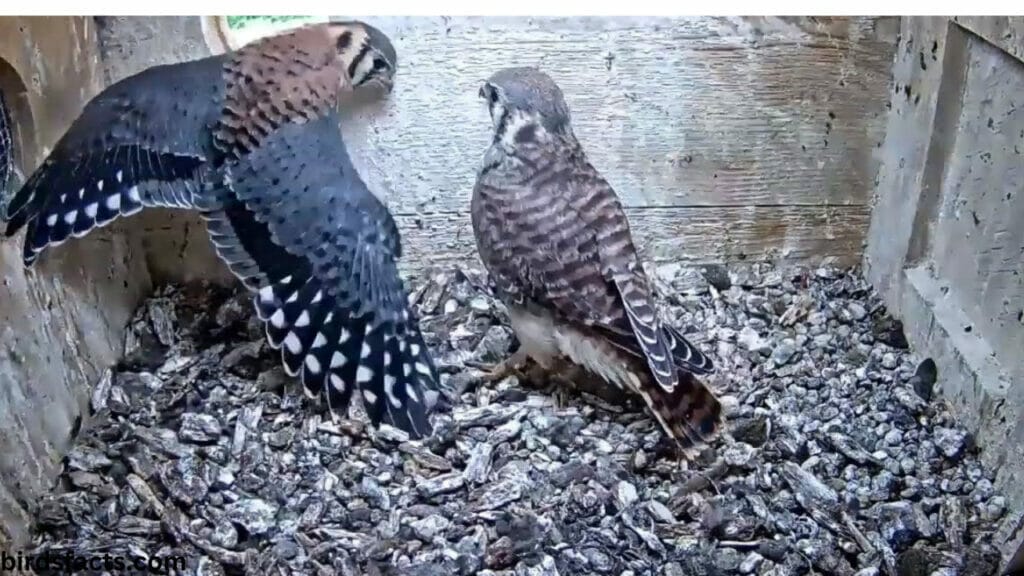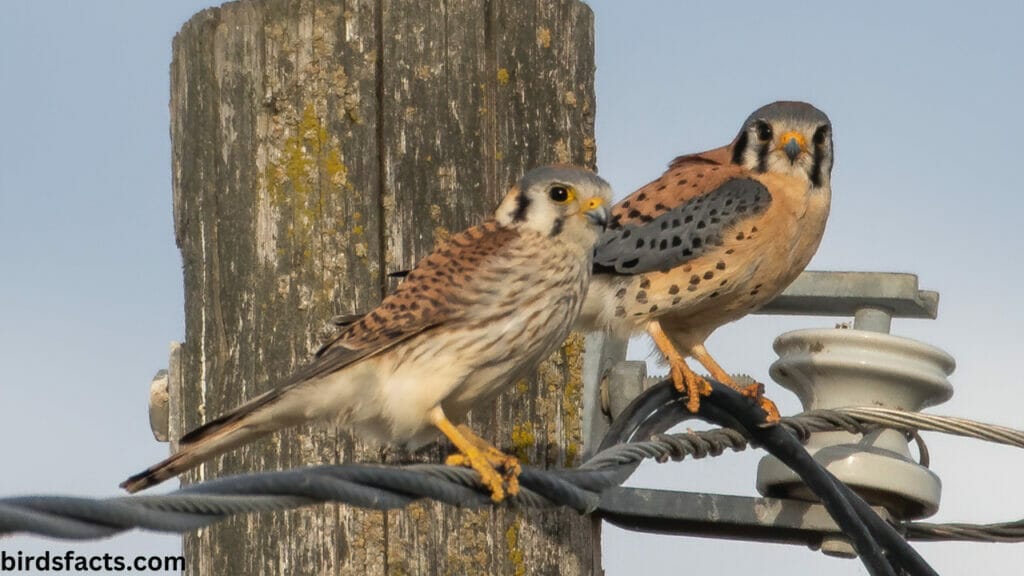Introduction
Kestrels are beloved birds of prey admired for their beauty, intelligence, and aerial prowess. With their striking plumage, large eyes, and graceful flight, these birds have captivated people for centuries. Learn more about the amazing kestrel and why it has become one of the most beloved birds in the world.

Kestral
AMERICAN KESTREL
The American Kestrel is a small and beautiful falcon that is found across North and Central America. This species of the falcon is considered to be one of the most colorful birds in North America, with its bright red, orange, and yellow plumage.
The American Kestrel is one of the most common birds of prey in the US and is found in deciduous and coniferous forests, open fields, urban parks, and agricultural areas. They have an incredibly wide range, from the Arctic Circle in Canada to the tip of South America.
The American Kestrel is a magnificent bird that offers a glimpse into the fascinating world of falcons. From its beautiful plumage to its melodious calls, the American Kestrel is a species that is sure to delight any bird lover.

AMERICAN KESTREL
Physical Characteristics
Kestrels are typically characterized by their slender, pointed wings and long, narrow tails. They have a unique flight pattern that is both graceful and agile. Additionally, the kestrel has the ability to hover in place while hunting, making it a favorite among birders. Kestrels typically measure between twelve and fifteen inches in length and weigh between four and six ounces. They have a wingspan of up to twenty-five inches.
Kestrels are known to be quite vocal, with a range of calls and songs used to communicate. They are also quite territorial and will guard their territory fiercely. They are known to be quite aggressive when defending their territory, and will often dive-bomb any intruders.
Kestrels can live up to fifteen years in the wild and are known to be quite adaptable. They are found in a variety of habitats, from open fields to woodlands and even urban areas. Kestrels are known to feed primarily on small rodents and insects, supplemented with a variety of fruits and vegetables. They have been known to also take small birds as prey.

kestral hawk
Hunting Adaptations
Kestrels have several adaptations that make them excellent predators. Their eyesight is incredibly sharp, allowing them to detect prey from a distance. Kestrels also have a remarkable ability to hover in the air, which gives them a better chance of spotting their prey. In addition to these adaptations, kestrels possess impressive aerial maneuvers, including sudden dives and sharp turns.
Kestrels hunt primarily small animals like mice, small birds, insects, and reptiles. But they also have an appetite for larger prey, including rabbits and hares. To capture these larger animals, kestrels must employ different strategies.
Kestrels are known to stalk their prey by walking slowly on the ground and listening for rustling in the undergrowth. They will also use their sharp eyesight to scout out a potential meal, then swoop in for the kill. Once a kestrel has spotted its prey, it will hover in the air and use its powerful talons to snatch the animal.
Kestrels also use their keen hearing to detect prey from a distance. They can identify the sound of a mouse scurrying beneath the leaves or a bird calling from the branches. By honing in on these sounds, kestrels can pinpoint their prey’s exact location and swoop in for the kill.

kestral bird
Diet
The Kestrel bird has a diet that is both varied and nutritious. They feed mostly on small rodents, frogs, lizards, snakes, insects, small birds, and other small animals. They also have the ability to hunt many of these small animals, making them an efficient predator.
Kestrels are omnivores, meaning they eat both plants and animals. They prefer to eat a variety of foods, including fruit, nuts, seeds, and berries. They also take advantage of the abundance of insects and small animals in the area, supplementing their diet with these additional sources of food.
Kestrels also get a lot of their necessary vitamins and minerals from their diet. They are especially fond of eating high-protein items such as insects and small snakes. These animals are high in essential amino acids, which are essential for maintaining good health.
Nests and Nest Building
But Kestrels are also known for their nest-building abilities. Kestrels build some of the most intricate nests of any bird species. They are also known for their loyalty to their nest site, returning to the same nest year after year.
Kestrels build their nests in a variety of places and locations. They can build them in trees, cliffs, and even buildings and man-made structures. Kestrels prefer to build their nests in areas with plenty of open skies, so they can keep an eye out for potential prey.
Nests are built from a variety of materials and Kestrels use whatever is available in their area. They build their nests from grass, twigs, and even leaves and feathers. Kestrels also line the inside of their nests with soft materials like moss and fur to make them more comfortable for the young.
Kestrels are very devoted to their nest building and take great care to ensure that the nest is well-constructed and safe for their young. They will often spend several hours constructing their nest before taking a break. Kestrels are also very good parents, spending much of their time sitting in the nest and keeping their young safe. They will often bring their young food and keep them warm throughout the day.

kestral – wings of fire
Preferred Habitats
Kestrels are most comfortable living in open areas, where they can easily spot their prey. They prefer to feed on small mammals, birds, and insects, but they will also feast on carrion, small reptiles and amphibians, and even fruits and seeds. They generally hunt from a high perch, and they are quite agile in the air, able to make sharp turns and sudden dives.
Kestrels prefer to nest in cavities, such as tree hollows, rock crevices, and even buildings. They are also known to use abandoned nests of other birds, such as those of crows or magpies. They may also choose to nest on the ground, particularly in areas with dense grasses or other vegetation.
Kestrels are also known to roost in trees, either alone or in small groups. They are more likely to do so in the evening and during the winter months.

kestral bike
Migration Patterns
Kestrels are found in a variety of habitats, from open grasslands and wetlands to mountain forests. During the warmer months, they can be spotted in the fields and meadows of the Northern Hemisphere, where they feed on insects and small mammals. In the winter, they migrate to the tropics, where they can find more plentiful food sources.
Kestrels migrate in large flocks and often travel in a V-formation which helps them to conserve energy. They typically migrate at altitudes of up to 5,000 feet, but some species can migrate as high as 10,000 feet. They are also known to be quite vocal while they fly, with loud calls that can be heard from afar.

Migration Patterns
Kestrels have a unique pattern of migration, with some populations making a complete round-trip migration, while others only make one-way trips. It is thought that the birds use environmental cues such as temperature, humidity, and the position of the sun to determine the best time to migrate. They also tend to migrate along the same routes year after year, which suggests that they have a good memory and can recognize the landmarks they need to follow.
Adaptations to Survive
Kestrels are also equipped with a set of claws that help them to catch their prey. These claws are very sharp and can help the kestrel quickly grab its prey. Kestrels also have an impressive wingspan that helps them fly at great speeds and with precision.
Kestrels are also well-adapted to survive in cold climates. They have a thicker layer of feathers than other birds of prey, which helps them to stay warm. Kestrels also have a greater metabolic rate than other birds, which helps them to stay warm during cold nights.
Kestrels also have an incredible ability to store food for long periods of time. This allows them to survive in areas where food is scarce, especially during the winter months. Kestrels will often store their food in tree cavities or in hollowed-out logs. Kestrels are also known for their remarkable hunting skills. They are capable of catching small prey, such as rodents and insects, in mid-flight. This skill is essential to their survival, as they need to feed regularly in order to stay healthy.
Conservation Efforts
Kestrels are also well-adapted to survive in cold climates. They have a thicker layer of feathers than other birds of prey, which helps them to stay warm. Kestrels also have a greater metabolic rate than other birds, which helps them to stay warm during cold nights.
Kestrels also have an incredible ability to store food for long periods of time. This allows them to survive in areas where food is scarce, especially during the winter months. Kestrels will often store their food in tree cavities or in hollowed-out logs.
Kestrels are also known for their remarkable hunting skills. They are capable of catching small prey, such as rodents and insects, in mid-flight. This skill is essential to their survival, as they need to feed regularly in order to stay healthy.
Kestrels are incredibly adaptable and can survive in almost any environment. They have unique body shapes and features that allow them to survive in a wide range of climates and terrains. They also have exceptional hunting skills and the ability to store food for long periods of time. These remarkable adaptations help kestrels to survive in the wild and make them a remarkable species of bird.
Conclusion
The Kestrel bird is a small, beautiful, and agile species of falcon that is found throughout the world. It is known for its remarkable ability to hover in the air and for its impressive aerial hunting skills. Kestrels make great pets for bird enthusiasts, and their unique characteristics make them fascinating species to observe. With its distinct plumage, impressive hunting skills, and remarkable ability to hover, the Kestrel is truly an amazing bird to behold.
Further Reading
You may also check out:








